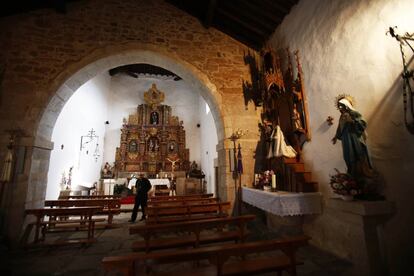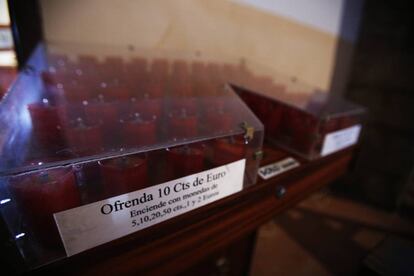Spanish thieves find easy source of loot: unprotected churches
Isolated places of worship in rural Spain are easy prey for crooks seeking jewels and cash


Father Fernando Ruiz is in charge of nine Roman Catholic churches within the diocese of Zamora, in northwestern Spain. All nine have been targeted by a gang of thieves that has attacked at least 58 places of worship across the province this year.
The isolation and lack of security measures at churches in rural Spain make them easy prey. Many of the dioceses worst hit by the string of robberies are located in Spanish regions with the greatest amount of small, out-of-the-way municipalities: Castilla y León, Galicia, Aragón and Castilla-La Mancha
Anything that gets auctioned off is checked against our historical database
Javier Moreno, Civil Guard art heritage expert
“Rural churches are weak points: in a village with very few residents, nobody ever hears a thing,” says Sergio Llata, the vicar general of the Santander diocese.
Thieves typically target the church’s collection box and any jewels on view. Occasionally they also make off with the tabernacle containing the consecrated Eucharist, possibly to be used in black magic rites.
It is a lot more uncommon for robbers to target the religious art, because of the difficulty of placing it on the market. Still, this year the Civil Guard seized 300 artworks taken from five churches in Burgos province.

Small-time crooks
Father Ruiz shows the effects of the attacks on the churches under his responsibility.
“This is the only door they had to unhinge,” he says in resigned tones, standing in front of the church of Videmala. This door is modern, but some of the other churches are protected by old-fashioned locks with long, antique-looking keys – the kind that are easily picked open.
In Videmala, on the night of May 2, the owner of the bar located next door to the church went home at 4am, while the baker went to work at 5am. Neither one saw or heard a thing.
Some of Ruiz’s churches have been broken into two weeks in a row. In Villalcampo, a police report says that on May 2 robbers took away “€120 from the collection boxes in two votive candle stands, and a gold-plated crucifix taken from the hand of a Baby Jesus figure.”
That same night, two more churches were fleeced of their parishioners’ donations, for a collective booty of €40. In Zamora, criminals took away the shiny objects and left behind much more valuable objects.
“These are small-time crooks,” notes Father Ruiz.
“A large parish church in Madrid may have around €300 or €400 in cash, but some others contain less than €20,” says Pablo Delclaux, the heritage coordinator at the Spanish Episcopal Conference (CEE).
No clear stats

The Civil Guard told EL PAÍS that it has no specific figures on church theft, but that there is a general trend.
“There are no statistics. We get the information, but often it is unclear and we don’t grant it full credibility,” says Javier Morales, who is in charge of the law enforcement agency’s Historical Heritage unit.
“The general evolution shows a drop in cases since 1998. However, beginning in 2007, there has been a slight change in this trend, with a moderate rise in cases.”
Security at small, countryside churches is hard to improve. “Alarms?” asks Father Ruiz. “It’s already hard enough for us to keep this temple up and running.”
In the larger churches, however, security does exist and may include surveillance cameras and night guards.
Placing stolen art
Stealing and selling religious artwork is more complicated: there isn’t much of a demand, and the police keep tabs on the market.
“It’s hard to imagine the younger generations decorating their homes with a Baby Jesus,” notes Morales. Even the Spanish Roman Catholic Church agrees: “Who is going to purchase a 1.50-meter tall Saint Pancras and put in inside their house?” wonders Delclaux, of the CEE.
And the difficulties do not end there.
Role games and black Masses
Occasionally, desecration is the real goal of the intruders. The vandalism ranges from graffiti to decapitated statues or theft of consecrated Eucharists.
These actions may be motivated by role games, initiation rites among members of criminal gangs, and even black Masses.
Vicente Jara, a expert on sects, notes that these cases are rarely reported. “If there was sacrilege, the prevailing attitude is usually to pretend that nothing happened.”
“It is hard to place on the market. Not long ago someone made off with a brass tabernacle from the 1970s, which they took apart to sell the parts, and they left behind an old chalice,” says Llata, the Santander vicar.
Even so, between December 2015 and September 2016 the Civil Guard recovered around 350 stolen items in two of the largest raids of the last few years.
The suspects are two young men ages 23 and 24 who sacked five churches in the Burgos diocese, taking everything they could find: altarpieces, tabernacles, sculptures, chalices. Their actions were guided by an art dealer who was also arrested in the operation.
Investigators are still trying to determine how this individual sold the stolen goods. In one case, they walked into an traveling art fair in Cantabria and found an antiques dealer from Alicante who was offering a Virgin Mary sculpture suspiciously similar to one that had been stolen in Burgos. However, its appearance had been altered.
“A dagger it used to hold had been removed, it was now wearing a crown, and one of the colors was different,” recalls Civil Guard Captain José Manuel Garrido. But other details in the color scheme coincided.
Ultimately, investigators found the booty in Alagón, Zaragoza.
“We needed several vans to load the items, it was a regular warehouse,” says Garrido.
The stolen artworks will probably not be returned to their respective churches, but be placed instead inside the Burgos Altarpiece Museum.
Churches have inventories of their art and images of any stolen item are quickly distributed among antique dealers and auction houses. Authorities also scour the internet for ads. “Anything that gets auctioned off is checked against our historical database,” says Morales.
English version by Susana Urra.
Tu suscripción se está usando en otro dispositivo
¿Quieres añadir otro usuario a tu suscripción?
Si continúas leyendo en este dispositivo, no se podrá leer en el otro.
FlechaTu suscripción se está usando en otro dispositivo y solo puedes acceder a EL PAÍS desde un dispositivo a la vez.
Si quieres compartir tu cuenta, cambia tu suscripción a la modalidad Premium, así podrás añadir otro usuario. Cada uno accederá con su propia cuenta de email, lo que os permitirá personalizar vuestra experiencia en EL PAÍS.
¿Tienes una suscripción de empresa? Accede aquí para contratar más cuentas.
En el caso de no saber quién está usando tu cuenta, te recomendamos cambiar tu contraseña aquí.
Si decides continuar compartiendo tu cuenta, este mensaje se mostrará en tu dispositivo y en el de la otra persona que está usando tu cuenta de forma indefinida, afectando a tu experiencia de lectura. Puedes consultar aquí los términos y condiciones de la suscripción digital.
More information
Últimas noticias
Pinochet’s victims grapple with José Antonio Kast’s rise in Chile
Reinhard Genzel, Nobel laureate in physics: ‘One-minute videos will never give you the truth’
How Japan is trying to avert ‘digital defeat’
The complicated life of Francesca Albanese: A rising figure in Italy but barred from every bank by Trump’s sanctions
Most viewed
- Pablo Escobar’s hippos: A serious environmental problem, 40 years on
- Why we lost the habit of sleeping in two segments and how that changed our sense of time
- Charles Dubouloz, mountaineering star, retires at 36 with a farewell tour inspired by Walter Bonatti
- Trump’s obsession with putting his name on everything is unprecedented in the United States
- The Florida Keys tourist paradise is besieged by immigration agents: ‘We’ve never seen anything like this’










































